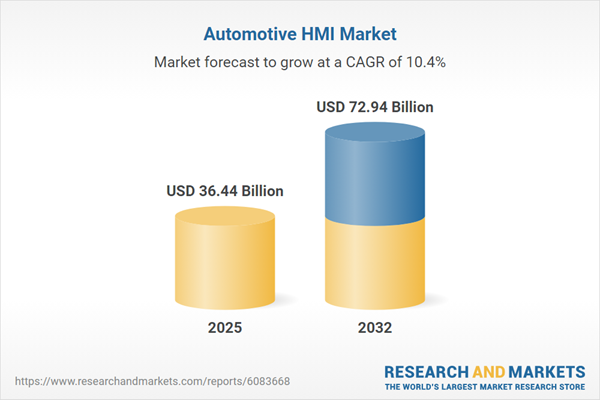Speak directly to the analyst to clarify any post sales queries you may have.
Senior automotive leaders face fast-evolving demands for connected, intuitive, and safe in-vehicle experiences. The automotive HMI market is transforming how manufacturers and suppliers approach driver engagement, technology integration, and operational agility, making strategic insight more critical than ever.
Market Snapshot: Automotive HMI Market Size and Growth Trajectory
The automotive human-machine interface market grew from USD 33.06 billion in 2024 to USD 36.44 billion in 2025. Expanding at a CAGR of 10.39%, it is projected to reach USD 72.94 billion by 2032. This rapid market growth is driven by convergence in sensor technology, artificial intelligence, and user-centric design, compelling OEMs and suppliers to re-envision driver engagement, connected mobility, and in-vehicle brand differentiation for a dynamic global landscape.
Scope & Segmentation
- Interface Types: Gesture recognition systems (three-dimensional and two-dimensional), head-up displays (combiner and windshield AR), touchscreens (capacitive, infrared, resistive), and voice control technologies (AI-based assistants, basic voice commands).
- Applications: Climate control (automatic, manual), infotainment (audio, connectivity, video), navigation (map-based, real-time traffic), and vehicle control interfaces (brake management, seat adjustment).
- Technologies: Acoustic wave (guided and surface), capacitive (projected, surface), projective, and resistive (five-wire, four-wire) interfaces.
- Distribution Channels: Aftermarket installations and OEM fitment options cater to shifting market access strategies.
- Vehicle Types: Commercial vehicles (heavy, light), electric vehicles (battery EV, hybrid EV, plug-in hybrid EV), and passenger cars (hatchback, sedan, SUV).
- Regions Profiled: Americas (North America, Latin America), Europe, Middle East & Africa (including major subregions), and Asia-Pacific (China, India, Japan, Australia, South Korea, Indonesia, Thailand, Malaysia, Singapore, Taiwan).
- Company Coverage: The research examines recent activities and strategies of 3M Company, Alpine Electronics Inc., Altia Inc., Capgemini SE, Continental AG, Delphi Technologies by BorgWarner Inc., HARMAN International by Samsung Electronics Co., Ltd., In2tec Ltd., Intellias, and Luxoft Holding, Inc.
Key Takeaways for Senior Decision-Makers
- Automotive HMI interfaces now deliver sophisticated, multimodal user experiences with gesture, touch, and AI-driven voice features that adapt to evolving consumer demands.
- Integration of AI, real-time analytics, and cloud connectivity elevates the role of in-vehicle systems from basic control to predictive, adaptive support for drivers and passengers.
- Regulatory shifts, especially in the Americas and EMEA regions, necessitate intuitive and safe HMI solutions that align with stricter compliance mandates and safety expectations.
- Diversified sourcing and advanced supply chain optimization, including nearshoring and dual sourcing, are gaining importance as companies seek both resilience and cost-efficiency for HMI components.
- Strategic partnerships between electronics firms, semiconductor suppliers, and software specialists accelerate product innovation, enabling ongoing updates and differentiation in a crowded market.
Tariff Impact and Supply Chain Considerations
The 2025 enactment of new US tariffs on core HMI components has placed additional cost pressures on manufacturers and suppliers. In response, many industry leaders are reassessing sourcing models, deploying nearshoring, and building inventory flexibility to safeguard against price shocks. These shifts not only affect cost structures but also compel closer collaboration with regulators to secure possible exemptions for safety-critical technology, ensuring continuous innovation and compliance.
Methodology & Data Sources
Research findings are grounded in a rigorous methodology that draws on secondary data analysis, expert interviews, quantitative trend tracking, and multi-stage validation. This structured approach ensures the insights reflect real-world market movements, regulatory impacts, and stakeholder perspectives while maintaining accuracy through peer review and field observation.
Why This Report Matters
- Provides actionable decision support for aligning technology strategy, procurement, and compliance for future-proofed HMI investments.
- Enables leaders to benchmark offerings, anticipate regulatory or policy risks, and identify avenues for competitive differentiation in the automotive HMI landscape.
Conclusion
Staying ahead in the automotive HMI market requires a strategic balance of technological innovation, operational resilience, and close regulatory alignment. This report equips senior leaders with the insight needed to prioritize investments, foster partnerships, and navigate a fast-evolving landscape.
Table of Contents
3. Executive Summary
4. Market Overview
7. Cumulative Impact of Artificial Intelligence 2025
Companies Mentioned
The companies profiled in this Automotive HMI market report include:- 3M Company
- Alpine Electronics Inc.
- Altia Inc.
- Capgemini SE
- Continental AG
- Delphi Technologies by BorgWarner Inc.
- HARMAN International by Samsung Electronics Co., Ltd.
- In2tec Ltd.
- Intellias
- Luxoft Holding, Inc.
Table Information
| Report Attribute | Details |
|---|---|
| No. of Pages | 187 |
| Published | November 2025 |
| Forecast Period | 2025 - 2032 |
| Estimated Market Value ( USD | $ 36.44 Billion |
| Forecasted Market Value ( USD | $ 72.94 Billion |
| Compound Annual Growth Rate | 10.3% |
| Regions Covered | Global |
| No. of Companies Mentioned | 11 |









